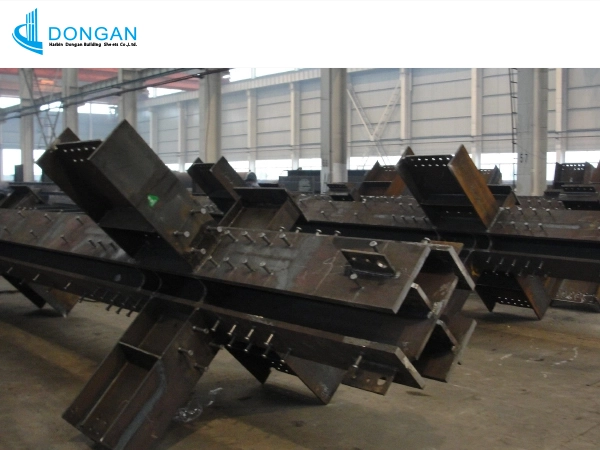Steel structures today provide the framework of contemporary architecture due to their higher strength, durability, and adaptability in design. Among all the structural members that compose the structures, cross columns are especially emphasized by their innovation and efficiency. As a member unit within the fabricated steel structure system, cross columns serve the purpose of augmenting the structural stiffness with their simplicity in construction.
In this technical paper, we will discuss the benefits, technicalities, and interdisciplinary uses of cross columns. We will learn why they are an imperative in fabricated steel building structures and how they are paving the way to future international industrial, commercial, and infrastructural ventures.

Knowledge of Cross Columns: Design and Structure
Structural Arrangement
A cross column is a very specialist load-carrying member comprising the two or more steel section arrangement—typically H-beams or I-beams—in cruciform position. The two can be made possible by:
- Welded construction: Wherein steel sections are riveted for good and all by high-precision welding
- Bolted assembly: Giving modularity with flexibility for application in specific situations
- Hybrid systems: Both solutions in combination for the best capability
Material Specifications
Current cross columns utilize:
- Structural high-strength steel (ASTM A36, A572, etc.)
- Fire-resistant coatings to resist exposure
- Ultimate protection with fire-resistant coatings
Manufacturing incorporates stringent quality inspection (e.g., ISO 3834 for welding), ensuring repeat performance on every unit manufactured.
Technical Advantages of Cross Columns
1. Better Load Distribution
Cross-column design provides:
- Biaxial symmetry for even distribution of loading
- 40-60% torsional strength compared to one-section columns
- Better moment resistance in different directions
2. Economy of Space
Cross columns provide:
- Less space consumption compared to ordinary columns (space saving by 30%)
- Larger clear spans with architectural openness
- Minimum foundation with efficient load transfer
3. Seismic Behavior
Tests indicate that cross columns exhibit:
- 25-35% better energy dissipation under seismic loading
- Reduced drift between stories in high-rise structures
- Better post-seismic serviceability
Cross Columns in fabricated Steel Structure Systems
Prefabrication Benefits
Uses of cross columns in factory-prepared steel structure systems benefit in the following segments of construction. Extremely high accuracy, dimensional tolerance only ±2mm, while that of traditional cast-in-place concrete is ±10mm, enables a 60-70% reduction in work on site to be done much quicker
Connection Technologies
Advanced cross columns utilize innovative connection technologies:
- End-plate connections for effective bolted connections
- Moment-resisting joints for seismically active regions
- Variable column height modular splice systems
All these innovations have made cross columns especially well-suited for:
- Tiered building construction projects
- Vertical additions to existing buildings
- Temporary structure uses
Extended Applications in Various Industries
1. Tall Building Construction
Case Study: Cross columns in Shanghai Tower were employed in its:
- Core structural system
- Outrigger truss connections
- Wind load resistance system
Achieved:
- 24% decrease in material costs over conventional designs
- 14% saving in construction time
2. Industrial Structures
Cross columns are best suited for:
- Heavy factory structures (crane load capacities of up to 100 tons)
- Powerhouses (resistance to dynamic and vibration loads)
- Cold storage structures (support of insulated panel structures)
3. Infrastructure Building
Major applications include:
- Airport terminals (long-span roof supports)
- Transportation terminals (glass wall glazing integration)
- Pedestrian walkways (exposed structural members for architectural purposes)
4. New Applications
- Modular skyscrapers (column modules that can be stacked)
- Offshore platforms (corrosion-free designs)
- Disaster-resistance homes (rapid-deployment systems)
Sustainability Impacts
Cross column makes environmentally friendly building design contributions in the following ways:
Material Efficiency
- 90-95% recycling rate
- Up to 40% material savings compared to similar concrete systems
Construction Waste Minimization
- 75-85% reduction of site waste compared to traditional methods
- Elimination of steel scrap by precise cutting
Lifecycle Impacts
- 50+ year design life with maintenance
- Building re-use and reuse flexibility

Future Trends and Innovations
Cross column technology innovation comprises:
- Intelligent columns with sensors integrated into the column for structural health monitoring
- 3D-printed nodal joints for complex geometry
- Advanced composite materials for next-generation performance
- AI-optimized structure for site conditions
Conclusion
Cross column is a steel structure engineering breakthrough offering the best structural performance in combination with the efficiency of fabricated steel structure systems. With the practice of construction still behind innovation in speed, sustainability, and flexibility, cross columns can only reign in global building practice.
From facilitating the design of next-generation supertall buildings to revolutionizing the design practice of industrial building structures, the performance and flexibility of cross columns make them a key element of current structural engineering. With the future bringing material science and fabrication technology further ahead, it is only to be expected that there will be an even wider variety of applications of this cruciform solution in the decades to come.
For builders, engineers, and architects, an understanding and application of the full potential of cross columns shall be key to offering the next generation of affordable, sustainable, and resilient buildings across the globe.






